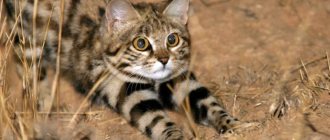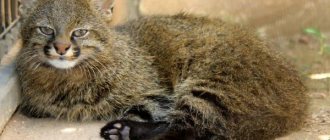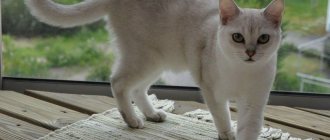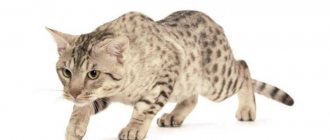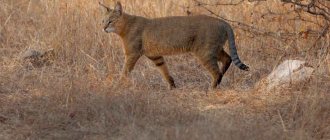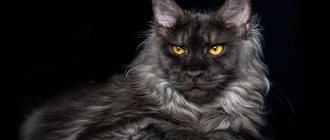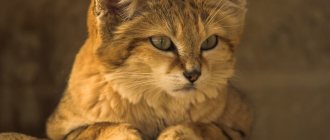Interest in the wild swamp cat (sometimes called the lynx or house) begins with its pedigree and participation in the formation of breeds of modern domestic cats. Nowadays, this predator is listed in the Red Book due to the small population, but previously its habitat covered a vast territory - from northern Africa to the Far East.
With such a vast geographical distribution, it is not surprising that the structure of the body of modern domestic pets shows traces of the participation of the jungle cat in the evolution of the species. Therefore, every cat in the depths of the genotype is a little house.
History of the breed
Felis chaus is an ancient breed that the Egyptians were the first to try to domesticate about 3 thousand years ago. Back then, hunters used the Nile cat to hunt waterfowl. Egyptian scrolls depict swimming animals that bring game to humans. In ancient times, the breed lived in at least 25 countries, but everywhere the animal had a reputation as a dangerous, wild predator, which people tried to avoid.
The beast was a serious problem for the population of the villages, as it hunted pheasants and muskrats. After the onset of cold weather, the predator moved closer to people’s houses and attacked poultry. Hunters caught wild cats to use their skins for farming. The jungle cat is not a domestic animal, but a predator living in the wild. In the 18th century, breeders were able to develop a special breed - the “house”, which is a hybrid of the reed lynx with an ordinary cat.
In the 20th century, sociable, friendly “Houseies” appeared in the United States, which were born by crossing wild jungle cats with short-haired domestic cats. This is how the Jungle Curl, Stone Cougar, and Chausi (Housey) breeds appeared, keeping them at home is safer and more legal. Breeders were able to develop breeds that retained the external beauty, large size and disposition of a wild nocturnal animal, combined with the docility of a domestic pet.
History of the origin of the breed
The first scientific mentions of jungle cats appeared only 3 centuries ago.
- 1776 Traveler, biologist and naturalist Johann Güldenstedt first describes the animal he encountered on an expedition along the southern borders of Russia. This wild cat was caught in the valley of the Terek River and was named “Chaus”.
- 1778 German naturalist Daniel von Schreber used the term chaus as the name of an entire species. Since then, the wild jungle cat has received scientific recognition.
Subsequently, they repeatedly tried to challenge Schreber’s classification, but the name “house” was already assigned to a cat from the wild jungle. That's what they began to call it in the West.
Images of animals very similar to the jungle cat are found in ancient Chinese books and on Egyptian frescoes.
This is interesting! In 1995, felinologists registered a new breed and named it Chausie - a cross between the parents of a wild jungle cat and an Abyssinian cat.
Chausie cat
What does a jungle cat look like?
The resemblance of the reed cat to a lynx is reflected in the red-gray coat color, long strong legs, and the presence of small tufts on the ears. Despite these similar features, the swamp cat has a significantly smaller body size than the lynx. It is characterized by:
- height at withers up to 50 cm, body length – 60-90 cm and weight from 5 to 12 kg;
- thin, short tail (20-30 cm);
- medium-sized round head with large erect ears, an elongated muzzle (barely noticeable tassels on the ears);
- sharp, retractable claws;
- eyes with vertically elongated pupils;
- dense, thick coat (fluffier in winter, sparse and coarse in summer).
Subspecies of Houses
The color of the predator depends on its habitat. Thus, in South Asia, red-brown cats are more common; in Central Asia and on the African continent, the coat color has gray-yellow shades. Animals living in cold conditions have a furry coat that is more fluffy, thicker, and longer. House subspecies differ in color, which can be:
- gray;
- brown;
- olive;
- red;
- whitish;
- with transverse stripes;
- with small fuzzy spots
Under state protection
Yes, in Russia the reed cat is protected by the Red Book. There are few of these animals left in nature, but they are still found on the coast of the Caspian Sea, in Central Asia, in Dagestan and in the Volga-Akhtubinskaya Floodplain Natural Park.
Animals love to settle near bodies of water. Dense reeds and coastal bushes provide shelter for them. Predators feed on fish, birds, and small animals.
Fluffy robbers feast on eggs and do not disdain frogs, lizards, and non-venomous snakes.
Yes, these dexterous, agile, strong animals with sharp claws and fangs can easily cope with a domestic duck or chicken, and even a rabbit will be in trouble. That is why the local population exterminates wild cats to protect their farmsteads. Poachers have also significantly reduced this species from the cat family.
Interesting to know:
in Russian schools, starting from the 2nd grade, children are taught about the Red Book. And that rare, endangered species of animals and birds are brought there, which must be protected and protected.
Where does it live?
Swamp lynx, house, jungle or Nile cat - all these are names for one representative of the cat family that lives in tugai forests and dense reeds. Representatives of the breed lead a solitary lifestyle, do not like open areas, but sometimes make forays and come to desert places with lumpy sands. However, the animal does not go far from its habitat. In winter and spring, the predator enters settlements to hunt poultry. In mountainous areas, the house does not rise above 100 m, since heat-loving cats do not like frost and snow.
Houses are attracted to the banks of ponds with lush vegetation, where they can hunt ducks and other animals. Cats make shelters in thickets of reeds or intertwined bushes. At the same time, the animal does not make holes, preferring to occupy ready-made abandoned dwellings of foxes or badgers. Marsh lynxes do not stay in one place for a long time, periodically changing shelters. Cats often approach the coastal strip, leaving tracks on muddy areas and shallows.
Cats swim well, dive for fish, and dive into water to eliminate their own smell. The latter distinguishes the jungle cat from the domestic breed, which tends to leave odorous traces everywhere (this is how the animal marks its territory). Wild cats live in the territory:
- Kazakhstan;
- low-lying banks of the Nile and Volga;
- Indochina;
- Iran;
- Dagestan;
- Eastern Turkey;
- India;
- Palestine;
- Caucasian forests;
- river openings of Central Asia.
From a wild “wow”...
A slender, muscular body, long strong limbs, a chiseled, attentive muzzle, triangular ears, iridescent grayish-yellow fur - the jungle cat looks, like any member of the family, royally magnificent. But she doesn’t like to show off her beauty, preferring to hide from prying eyes among the dense thickets of coastal grasses and shrubs. Range: Transcaucasia, Asia, Hindustan, Indochina, southwest China. Where the jungle cat lives, there are always a lot of secluded places - these are not shy, but secretive, cautious and non-aggressive animals. They avoid humans, presenting a danger only during the period of mating and raising offspring. And only if the slow-witted biped does not want to leave the territory protected by the male.
For its passion for water and the habit of settling along the banks of rivers, lakes and seas, the wild reed cat was nicknamed the swamp lynx. Although outwardly this representative of the feline family resembles a lynx only vaguely - a medium-length tail and small tufts on the ears, which are expressed only in adult males. Another name for the species is the house jungle cat (Filis chaus). The species includes ten subspecies, similar in appearance and habits, but slightly different in size and color.
The marsh lynx is an excellent hunter and fisher. These are agile, jumping and strong animals that can cope with small ungulates. But usually a wild reed cat is content with a fish masterfully picked up by sharp claws or a bird knocked down from the ground on takeoff. And for dessert - waylaid rodents, caught turtles and other reptiles, found eggs.
Jungle cat kittens are painted with bright spots and stripes - a kind of childish camouflage that disappears with the onset of maturity. By six months, a grown-up kitten says goodbye not only to the pattern on its fur coat, but also to its parents, setting off in search of its own hunting grounds. Males are extremely pugnacious, especially if a “bride” lives nearby, and fiercely guard “their” 50-200 km², resounding around the area with sharp, creaky cries of “wow-wow”.
Commercial hunting for the reed cat is not carried out - the fur, fortunately, is of little use for dressing, wears out quickly and does not warm well. Light spotted fur coats made in China, sold under the name “reed cat fur” - a product made either from artificial fur or from the skins of an Asian leopard cat, which is actually spotted. The swamp lynx is almost uniformly colored, with stripes only on the tail and the lower part of the paws - no “leopard” patterns. In this regard, the Hausa jungle cats were lucky, but they were overtaken by another misfortune - the coastal territories are being actively developed, and there are fewer and fewer places to live.
Over the past three decades, marsh lynxes have practically disappeared from the banks of the Volga. IUCN and the Red Book classify the jungle cat as a rare endangered species: the purchase is accompanied by an agreement and a certificate, without which the transaction and the very fact of keeping a wild animal are considered illegal.
Lifestyle of the swamp lynx
The swamp lynx lives in dense lowland forests near rivers and lakes. The cat makes a shelter in the depths of reed thickets, often right on the ground, lining the rookery with wool and dry plant stems. Sometimes it spends the night in the burrows of other animals, but never digs the ground itself. The swamp lynx avoids open places, prefers to move along different paths and easily makes its way through thickets of thorny bushes. The house endures cold winters with difficulty, since it is a heat-loving animal.
The animal leads a solitary lifestyle, with the exception of the mating season: during the breeding season, the cat takes on a partner. The female and male live and take care of the growing offspring together, dividing the prey among everyone. The house hunts on an area from 45 to 180 square meters. km., depending on the region of residence. The male's territory overlaps with the habitats of several females. The reed cat is an excellent swimmer and diver, but does not like to climb trees.
- How to lower cholesterol without drugs
- Additional compensation due upon dismissal
- How to cook fried chanterelle mushrooms with potatoes
Hunting and food
The predator has excellent hearing thanks to its large ears. The cat's vision is sharp, which helps him navigate well in the dark. At the same time, the swamp lynx cannot boast of a good sense of smell and distinguishes odors much worse than other felines. The jungle cat hunts at any time of the day, but prefers to get food in the dead of night or at dusk. For prey, as a rule, it goes into impassable thickets of reeds. It looks out for the victim from ambush, slowly and quietly creeping up and attacking it with a sharp jump, then grabs it with its paws and strangles it.
The diet of wild cats is varied: the animal catches fish, small rodents, crustaceans, land and waterfowl, reptiles, and insects. During seasons characterized by low temperatures, it gets close to human settlements and steals their poultry. A jungle cat can destroy bird nests; near rodent burrows, a predator can wait in ambush for its prey for several hours in a row. The predator is not afraid of snakes, dealing with them as quickly as with frogs.
Appearance and features
Compared to an ordinary cat, the reed cat has much larger dimensions. The body of a wild cat is from 60 to 90 cm in length, not counting the tail, which reaches up to 30 - 35 cm in length. The weight is also quite large - from 5 to 12 kg. The cat reaches half a meter in height at the withers. Smaller cats inhabit Thailand and the island of Sri Lanka, and the largest ones are seen in the Caucasus and Palestine.
It is not for nothing that the jungle cat is associated with the lynx, because its entire appearance clearly resembles it, both in color and in the funny black tassels on its ears. The color of the cat is grayish-sandy, similar to the color of dry reeds. There is a slightly pronounced pattern on it in the form of dark spots or stripes; it is more noticeable in young individuals and cubs, mainly the stripes are located on the paws and tail. The cat's fur is short and rough. In summer it sheds heavily, and by winter it becomes densely packed and very thick.
The color tone of Nile cats may vary slightly, it depends on the region of their habitat, it can be: light sand; reddish yellow; light brown; greyish yellow. The paws of jungle cats are very powerful, strong with large sharp claws. The reed cat's muzzle is round and elongated towards the bottom, of medium size relative to its physique. The external features of the Nile cat are fully consistent with all cats, and the color of the coat allows it to easily blend into the natural landscapes of the places where it lives.
Reproduction and care of kittens
The mating season begins in February-March and can last until April. This time passes tensely, with brutal fights between rivals and loud screams. At this time, cats are especially aggressive, so it is better for humans or other animals not to come into contact with them. The conquered female accepts the courtship of the gentleman and begins to prepare for the birth of offspring. The reed lynx finds a suitable place for shelter and insulates it with its own fur.
The offspring are born in May (pregnancy lasts 2 months), and their number is always different - from 2 to 6 individuals, rarely 10 kittens are born at once. In a large litter there are fewer females than males. The kitten's weight is 60-100 g, the cubs are born blind, opening their eyes in the second week of life. The cat feeds them with milk for up to 3 months, and from two months they are gradually accustomed to regular food. The stages of growth are accelerated, while the father does not leave the family and take care of him throughout the entire period of growing up of the kittens. From 5 months they no longer need parental care.
Personality of the pet
By its nature, the jungle cat is a pronounced predator . Even domesticated breeds prefer a nocturnal lifestyle; they are extremely active, tireless and inquisitive. If keeping a wild animal in captivity is a dubious pleasure, then domesticated varieties are distinguished by a calm disposition, they are friendly and extremely interesting to keep.
The so-called Chausie , which is a hybrid of an Abyssinian cat and a jungle cat, are very popular today. In appearance, Chausies are practically indistinguishable from their wild ancestor, but at the same time they are calm and friendly animals that do not cause any difficulties when kept in captivity.
Do not forget also about the need for castration and sterilization of animals . This will not only prolong the life of pets, but will also save the homeowner from any difficulties with an unpleasant odor from an animal that may be marking its territory.
When keeping a jungle cat at home, you should definitely buy a scratching post and a large tray . These animals need open, free space and also love to swim, so you should bathe your pet from time to time.
Is it possible to keep a wild jungle cat at home?
The high price and expensive maintenance of the breed often discourages cat lovers from purchasing such a pet. If you decide to purchase an exotic predator, be sure to study the character traits of the jungle cat. If you are not willing to devote a lot of time to raising an animal, it is better not to get such a problem pet.
An adult wild cane cat will not get along in a domestic environment, no matter how hard you try to tame it. The animal will be more comfortable in a specially equipped enclosure, and the cage area should be at least 3 square meters. m, and the height is about 5 m. If the conditions of detention are ignored, the mobility of the predator will be limited and the animal will get sick. The enclosure is fenced with a metal mesh, the floor is poured with concrete, on top of which a wooden flooring is laid or sprinkled with a mixture of sand and earth. It is advisable to arrange areas with herbaceous plants in the enclosure.
The cage is equipped with a doghouse type shelter, the bottom of which is laid with straw and wooden or stone terraces. The house uses a tray with filler as a toilet. Kittens brought home at 3 months or earlier are relatively easy to tame, but require a lot of attention. It is important to understand that even the cubs of jungle cats are not harmless: the animals have a capricious character, recognize only one owner and always follow him. The pet is wary of other family members and may snort and hiss at them.
Character and behavior of the predator
The jungle cat is very active, so those who want to have a calm animal should choose a different breed. It is better to bring a kitten into the house before the age of three months. The baby will choose one owner to whom it will be devoted; the animal will remain cool towards the rest. Strangers will also not be able to establish a relationship with the pet. A special feature of the Hausa is its love of water: all jungle cats love water treatments, but they should be taught to bathe as early as possible.
When starting a Chausie, remember that the animal needs care and affection, without which the pet remembers its wild past and becomes aggressive. If you do not have the opportunity to spend a lot of time with the animal, it is better to choose another breed. Adults meow loudly in a bass voice, while kittens only snort and hiss. Houses are willful and smart, they love space and freedom. During the mating season, jungle cats can show aggression towards people and other animals.
Representatives of the breed are faithful and devoted, but they will never become tame and will not sit on your knees. Houses are not recommended for families with children. The Reed Cat gets along well with other pets, including dogs and cats, as long as they are not aggressive. Small animals and birds in the house will be at risk. Jungle cats are very dexterous, curious and smart, they easily learn to open doors, remember where things interesting to them are, and easily climb the highest furniture.
- Living wage for a pensioner in 2021
- The surprising truth about six popular sauces
- Baked pork in a slow cooker
House character
The wild swamp lynx is a lover of fish, so love for water is in its blood - how else could a strong beauty be able to enjoy her favorite taste? At the same time, water cleanses the animal’s skin of dirt and odor.
Once you watch the animal for a little while, it will immediately become clear that this is an intelligent, inquisitive and completely tireless animal. Those who want to train their pet will really like the House - he is very easy to train, follows commands with interest and can get along with other four-legged neighbors.
It is unlikely that you will be bored with such a pet, but you should understand that this cat will never become completely domestic - wild nature is in his blood.
Features of maintenance and care
Domesticated representatives of the breed are very active, they need open space and active games. The optimal habitat for the animal is a country house. Cats love affection, walks with their owner on the street, they are adapted to relieve themselves in the tray, and do not require frequent brushing. Raising House kittens is a responsible process that requires patience, love, knowledge of the breed’s character traits and the basics of animal psychology.
The cat should be brushed daily during shedding, and once every 3-4 days after this period is over. Pets have an unstable coat change schedule: sometimes in winter there is no thick undercoat, since the living space is well heated, and summer, on the contrary, is cool, so the cat “insulates itself.” Focus on the amount of fur shed, not the season. It is better to use a brush with soft bristles. You need to bathe your pet when it gets dirty, not often. To prevent the animal from scratching the furniture, provide it with several scratching posts; they will save you from having to trim its claws.
In an apartment it’s good, but in a private house it’s better...
To keep a large, active animal you need a spacious apartment with sturdy furniture. After all, large and sharp claws can easily turn your home interior into tatters. It is better to have such pets in a country house with a separate enclosure for the pet. So that the furry baby has a place to sharpen his claws and frolic to his heart's content. Yes, I would like to remind you that the swamp lynx loves water, so a pool with fish can also come in handy.
House cat - reed lynx with domestic habits
The breed differs from other domestic relatives in external parameters, since it has a significantly larger size than almost any other cat: the height of an adult reaches 50-75 cm, and the weight is more than 16 kg. The characteristic features of the animal’s body constitution are a relatively short body, high front legs and a not very long tail; there are small tufts on the ears, which makes the animal look like a lynx.
Despite the fact that today it is fashionable to have exotic cats, Houses are rarely found at home. This is due to the high price and characteristics of keeping a pet. Wild cats are much more difficult to get used to people, so only small kittens under 3 years of age are allowed - their socialization is more successful. It is important for captive animals to maintain an active lifestyle. The best food for the breed is lean meat, but it must also be provided with the opportunity to receive live food (hunt), otherwise its instincts will become dull, the animal will begin to get bored and get sick.
Jungle cat at home
No matter how much you try to dissuade those who want to put a wild creature in their home, it will be of no use. It’s better to talk about how a domestic jungle cat .
Maintaining such an unbridled and active creation of a house will not bring pleasure to people who value their furnishings - everything that was in its place will be chewed, turned over or torn off. For home keeping, it is better to provide the animal with conditions close to natural, for example, organize an enclosure with a pond.
What does a domestic cat (reed cat) do in the house? He gallops as hard as he can around the rooms, rushes like the wind, jumps around the corner onto the owner’s feet, immediately rushing off and disappearing under the closet, as if in a secret lair. To prevent the animal from becoming the absolute master of the house, they begin to educate it from early childhood, simultaneously accustoming it to a scratching post and a tray. To satisfy the natural needs of hunting, you will need to treat the Hausa with live food.
Buy a jungle cat kitten
global $ads_google; //data-ad-slot=”2475549904″ $ads_google = empty($ads_google) ? false : true; ?> if ($ads_google == false) {?>
$ads_google = true; ?> } ?>
It is unlikely that anyone will be able to buy a marsh lynx in Russia, since there are no nurseries selling reed kittens here. Of course, you can find an advertisement on some website for the sale of a reed kitten, but is it really such, because you can buy an ordinary yard cat for a fabulous price.
If you have a wild desire to buy a Hausa, then you should not trust illegal sources that are not able to document either the purity of the breed or the state of health of the animal. In addition, when poachers offer an animal from the wild, and not one raised in a nursery in an enclosure, one should not even hope that the cat will become a pet.
The cost of a reed kitten will be no less than 3-8 thousand dollars, so a lower price should alert buyers.
How to choose a kitten
It is better to buy a baby cane cat at the age of 3 months - this is the optimal age for taming and starting to train the animal. It is also at this time that the difference between a House cat and a normal kitten born in the same litter becomes apparent. At 3 months, the animal should already have all its vaccinations. When choosing a kitten, pay attention to the following aspects:
- availability of the necessary set of documents certifying the breed and pedigree of the animal;
- the kitten's disposition should be cheerful, playful, affectionate;
- the baby must be accustomed to go to the tray and use a scratching post;
- Ideally, the animal should treat other kittens and strangers well and calmly.
Where can I buy
Buying a kitten is not easy, since only a few nurseries breed and sell House cats. An alternative to finding a specialized cattery is to buy a jungle cat at an exhibition of elite breeds. It is important that the animal has all the documents and vaccinations, but even with this there is no guarantee that the pet will grow up friendly and obedient. In Russia, the breed is bred in the following institutions:
- Ascheracat (Moscow);
- Lunicorn (Moscow region);
- Benabi (Saratov).
How much does a jungle cat cost?
It is difficult to purchase a representative of the breed not only because of the small number, but also the high price. Private nurseries breed and sell kittens. In addition to them, there are companies that sell wild cats and other exotic animals. In Russia, the price of a Hausa kitten ranges from 100-150 thousand rubles. If you find a cheaper option, there is a risk that they are trying to sell you ordinary kittens of a similar color.
Home content
Hybrids
It is also worth mentioning other domestic breeds that have jungle cats among their ancestors: Stone Cougar and Jungle Cairn.
Wild cats are very active and have a tough temperament, representing a huge danger to all animals in the area. Not even excluding dogs. Recognizing only one owner, these cats (and cats) require the greatest attention. If they don’t receive it, they can be very seriously offended, even to the point of temporarily leaving home. During love experiences, cats are also dangerous for people. Willful, very intelligent, loving space and complete freedom, jungle cats are not suitable for the role of pets. If anyone decides to have them at home, they should acquire them at a very early age, then there will still be a chance to cope with the characteristics and disposition of these predatory animals. And you shouldn’t expect the jungle cat to become a quiet sofa animal.
Purchasing a kitten
In Russia it is very difficult to find a kitten from the reed breed. But there are special nurseries at the service of lovers. You can also purchase the desired specimen at exhibitions of elite breeds. The price of a Houseie kitten is 5 thousand US dollars.
The kitten vaccination schedule is designed for 3 months, therefore, kittens should be purchased at this age
Please note:
- for the availability of the necessary set of documents, which verify both the breed and pedigree of the cat;
- the kitten’s disposition is playful, cheerful and affectionate, the cat tolerated the vaccination well, is healthy and ready to move;
- on the kitten’s habituation to going to the litter box;
- for the presence of a scratching post habit;
- the ability to calmly, even friendly, treat other kittens and strangers.
In addition, it is at three months of age that the difference between a Housie and a normal kitten born in the same litter becomes easily distinguishable.
Care
it's a troublesome and expensive task
Animals need space. From this point of view, a country house is preferable to a city apartment.
For good health, the Hausi must receive vaccinations on time, eat well and on time, and receive the necessary dose of ultraviolet radiation. Cats can live a long time, up to 14 years.
The learning ability of these animals is very high; they are easy to teach to open and close doors and use a potty. They obey their owner unquestioningly and calmly react to the presence of other domestic animals nearby (outside their territory, they will still terrorize “alien” animals). However, having received less attention from the owner, they can start hunting for “their” pets.
Among the characteristics of these cats, one should note their inherent curiosity and love of water.
Animals should be brushed once a week. The exception is the molting period, when brushing should be done daily. Claw trimming is not required; if there are scratching posts, then these cats will not damage the owners’ furniture.
When it comes to nutrition, reed cats are unpretentious and picky. The daily diet is basically 2 mice (or one rat) and 200 grams of meat.
Feeding rules:
In the first year of life, kittens eat 2 times a day; in subsequent years, a single daily meal is sufficient. It is important to have both live food and plant foods in the diet. If a house asks to treat him with a cucumber, zucchini or pumpkin, his request should be respected
and sweet fruits will not be superfluous in their diet. In general, the plant component in Hausa food should constitute a third of the total diet. boiled fish can be included in the menu, but not more than once a week to avoid rickets due to leaching of calcium from the bones. One day a week should be a fasting day. Food must contain vitamins and mineral supplements. Especially if the owners treat their pets with artificial food or purchased meat.
If outside the city cats can be provided with space to move, then in a city apartment they can become obese from a sedentary lifestyle and get sick from a lack of ultraviolet radiation. Therefore, walks with pets in the fresh air should be frequent, although not as regular as with dogs.
Mating is recommended after reaching 18 months of age, when puberty has occurred. The Hausi's partners can be Abyssinian or other short-haired cats; the litter will include both jungle cats and regular kittens. Pregnancy lasts 66 days.
If these conditions are met, the graceful and devoted jungle cat will become a true friend to its owner and their friendship will last a long time.
jungle cat
What and how to feed in captivity
The jungle cat eats once a day, and the diet consists of 200 grams of lean meat (mainly beef), 1 live rat or 2 mice). Live food can be day-old chicks or quails. You can give your cat fresh fish once a week. An important detail of the diet is fasting days, during which the predator fasts for the whole day. Your pet should be unloaded no more than once a week. Such strict measures are needed to save the animal from excess weight. To maintain your pet's health, follow these rules:
- Feed kittens up to a year 2 times a day, after a year - 1 time;
- be sure to supplement the animal’s menu with vitamins, mineral mixtures, and fresh herbs;
- do not refuse to feed plant foods or live food;
- Give your cat a fasting day once every 7-10 days.
